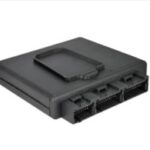Understanding the intricacies of your BMW E46’s ignition system can be crucial for troubleshooting starting problems. This guide provides a detailed explanation of the Bmw E46 Ignition Switch Wiring Diagram, outlining the key components and their connections.
The diagram highlights the critical components in the E46 starting system, using color-coding for clarity.
- GREEN (S2): Represents the ignition switch itself. This component delivers power to the system when the key is turned.
- RED (L1): Indicates the EWS toroidal coil located within the ignition lock cylinder. This coil acts as a receiver, communicating with the transponder chip embedded in your key. It sends a coded signal to the EWS module for authentication. It’s important to distinguish between the ignition switch (where power is switched) and the ignition lock (where the key is inserted).
A common point of confusion is differentiating between the ignition switch and the ignition lock cylinder. They are separate components. The ignition lock cylinder is where you insert your key, while the ignition switch is an electrical component typically located on the steering column that is activated by the key turning in the lock cylinder. See this eBay listing for a visual representation of the two separate parts: http://www.ebay.com/itm/BMW-Steering-Column-Ignition-Switch-Lock-w-Key-E46-X3-5-Spd-Manual-99-05-OEM-USE-/221189993987?pt=Motors_Car_Truck_Parts_Accessories&hash=item337ff37603&vxp=mtr
- BLUE: Denotes the Electronic Immobilizer Unit (EWS) module, positioned under the dashboard on the driver’s side. This module is the brain of the anti-theft system, responsible for verifying the key and enabling the starter.
- ORANGE (M): Represents the starter motor solenoid/relay. This component engages the starter motor, cranking the engine. Note that in the E46, there aren’t additional relays in the starter circuit. The EWS module directly controls the starter solenoid. This simplifies the wiring and diagnostics.
The LIGHT BLUE circuit represents the crucial communication pathway between the EWS module and the ignition lock. When a valid key is inserted, this circuit closes, allowing the EWS to enable the starter. Turning the key to position P3 (start) sends 12V from the ignition switch to the EWS. If the key is authenticated, the EWS completes the circuit to the starter solenoid, engaging the starter motor.
Specifically, a Black/Blue wire carries power from the ignition switch to the EWS module. A Black/Yellow wire then carries the signal from the EWS module to the starter solenoid.
Troubleshooting starting issues often involves checking for 12V at key points in this circuit.
-
No 12V from Ignition Switch to EWS (Black/Blue wire) in key position 3: Indicates a potential fault with the ignition switch itself.
-
12V at EWS but not from EWS to Solenoid (Black/Yellow wire) in key position 3: Suggests a problem with the key, the ignition lock (toroidal coil), or the EWS module. Diagnosing this requires specialized equipment due to the digital communication between the key and the EWS. A simple voltage test won’t suffice. Further diagnostics with a BMW specific scan tool are needed to pinpoint the faulty component. It could be an issue with the key’s transponder chip, the EWS coil in the lock cylinder or a fault within the EWS module itself.
This wiring diagram provides a foundation for understanding the starting system in your BMW E46. Remember to always consult a repair manual for specific details related to your model year.
